Effects of Maternal Chromium Restriction on the Long-Term Programming in MAPK Signaling Pathway of Lipid Metabolism in Mice
Abstract
:1. Introduction
2. Materials and Methods
2.1. Animals Protocol
2.2. Serum Chromium Levels
2.3. Measurement of Body Weight and Food Intake
2.4. Measurement of Serum Leptin, Adiponectin and Inflammatory Factors
2.5. Measurement of Serum Oxidative Stress and Antioxidant Markers
2.6. Measurement of Serum Total Cholesterol (TC), Triglyceride (TG), High-Density Lipoproterin Cholesterol (HDL), and Low-Density Lipoprotein Cholesterol (LDL)
2.7. Measurement of Adipose Tissue Weight
2.8. Methyl-DNA Immunoprecipitation and Microarray Hybridization
2.9. Differential Methylated Genes Pathway Analysis
2.10. Bisulfite Sequencing (BSP)
2.11. Quantitative Real Time RT-PCR
2.12. Statistical Analysis
3. Results
3.1. Maternal Body Weight and Serum Chromium Differences
3.2. Effects in Offspring
3.2.1. Effects of Maternal Low Chromium Diet on Serum Chromium Level, Body Weight, Food Intake, and Fat Pad Weight in Offspring
3.2.2. Effects of Maternal Low Chromium Diet on Serum Lipid Profile in Offspring
3.2.3. Effects of Maternal Low Chromium Diet on Serum Adiponectin, Leptin, and Pre-Inflammation Cytokines in Offspring
3.2.4. Effects of Maternal Low Chromium Diet on Serum Oxidative Stress and Antioxidant Markers in Offspring
3.2.5. Effects of Maternal Low Chromium Diet on Genome-Wide DNA Methylation in Adipose Tissue Collected from Offspring
3.2.6. Functional Analysis Using DAVID
3.2.7. Bisulfite Sequencing (BSP)
3.2.8. Real-Time RT PCR Assay for BSP-Validated Hypomethylated Genes and Downstream Genes
4. Discussion
5. Conclusions
Acknowledgments
Author Contributions
Conflicts of Interest
References
- De Rooij, S.R.; Painter, R.C.; Phillips, D.I.; Osmond, C.; Michels, R.P.; Godsland, I.F.; Bossuyt, P.M.; Bleker, O.P.; Roseboom, T.J. Impaired insulin secretion after prenatal exposure to the dutch famine. Diabetes Care 2006, 29, 1897–1901. [Google Scholar] [CrossRef] [PubMed]
- Barker, D.J.; Osmond, C. Infant mortality, childhood nutrition, and ischaemic heart disease in England and Wales. Lancet 1986, 1, 1077–1081. [Google Scholar] [CrossRef]
- Oken, E.; Gillman, M.W. Fetal origins of obesity. Obes. Res. 2003, 11, 496–506. [Google Scholar] [CrossRef] [PubMed]
- Desai, M.; Gayle, D.; Babu, J.; Ross, M.G. Programmed obesity in intrauterine growth-restricted newborns: Modulation by newborn nutrition. Am. J. Physiol. Regul. Integr. Comp. Physiol. 2005, 288, R91–R96. [Google Scholar] [CrossRef] [PubMed]
- Razin, A. Cpg methylation, chromatin structure and gene silencing—A three-way connection. Embo J. 1998, 17, 4905–4908. [Google Scholar] [CrossRef] [PubMed]
- Razin, A.; Shemer, R. Dna methylation in early development. Hum. Mol. Genet. 1995, 4 (Suppl. 1), 1751–1755. [Google Scholar] [PubMed]
- Wu, G.; Bazer, F.W.; Cudd, T.A.; Meininger, C.J.; Spencer, T.E. Maternal nutrition and fetal development. J. Nutr. 2004, 134, 2169–2172. [Google Scholar] [PubMed]
- Godfrey, K.M.; Lillycrop, K.A.; Burdge, G.C.; Gluckman, P.D.; Hanson, M.A. Epigenetic mechanisms and the mismatch concept of the Developmental Origins of Health and Disease. Pediatr. Res. 2007, 61, 5r–10r. [Google Scholar] [CrossRef] [PubMed]
- Onakpoya, I.; Posadzki, P.; Ernst, E. Chromium supplementation in overweight and obesity: A systematic review and meta-analysis of randomized clinical trials. Obes. Rev. 2013, 14, 496–507. [Google Scholar] [CrossRef] [PubMed]
- Anderson, R.A.; Kozlovsky, A.S. Chromium intake, absorption and excretion of subjects consuming self-selected diets. Am. J. Clin. Nutr. 1985, 41, 1177–1183. [Google Scholar] [PubMed]
- Anderson, R.A. Chromium in the prevention and control of diabetes. Diabetes Metab. 2000, 26, 22–27. [Google Scholar] [PubMed]
- Offenbacher, E.G.; Pi-Sunyer, F.X. Beneficial effect of chromium-rich yeast on glucose tolerance and blood lipids in elderly subjects. Diabetes 1980, 29, 919–925. [Google Scholar] [CrossRef] [PubMed]
- Suksomboon, N.; Poolsup, N.; Yuwanakorn, A. Systematic review and meta-analysis of the efficacy and safety of chromium supplementation in diabetes. J. Clin. Pharm. Ther. 2014, 39, 292–306. [Google Scholar] [CrossRef] [PubMed]
- Lefavi, R.G.; Anderson, R.A.; Keith, R.E.; Wilson, G.D.; Mcmillan, J.L.; Stone, M.H. Efficacy of chromium supplementation in athletes: Emphasis on anabolism. Int. J. Sport Nutr. 1992, 2, 111–122. [Google Scholar] [PubMed]
- Vincent, J.B. Recent advances in the nutritional biochemistry of trivalent chromium. Proc. Nutr. Soc. 2004, 63, 41–47. [Google Scholar] [CrossRef] [PubMed]
- Padmavathi, I.J.; Rao, K.R.; Venu, L.; Ganeshan, M.; Kumar, K.A.; Rao Ch, N.; Harishankar, N.; Ismail, A.; Raghunath, M. Chronic maternal dietary chromium restriction modulates visceral adiposity: Probable underlying mechanisms. Diabetes 2010, 59, 98–104. [Google Scholar] [CrossRef] [PubMed]
- Aiken, C.E.; Ozanne, S.E. Sex differences in developmental programming models. Reproduction 2013, 145, R1–R13. [Google Scholar] [CrossRef] [PubMed]
- Dabelea, D.; Crume, T. Maternal environment and the transgenerational cycle of obesity and diabetes. Diabetes 2011, 60, 1849–1855. [Google Scholar] [CrossRef] [PubMed]
- Taylor, B.A.; Phillips, S.J. Detection of obesity QTLS on mouse chromosomes 1 and 7 by selective DNA pooling. Genomics 1996, 34, 389–398. [Google Scholar] [CrossRef] [PubMed]
- Weber, M.; Hellmann, I.; Stadler, M.B.; Ramos, L.; Paabo, S.; Rebhan, M.; Schubeler, D. Distribution, silencing potential and evolutionary impact of promoter DNA methylation in the human genome. Nat. Genet. 2007, 39, 457–466. [Google Scholar] [CrossRef] [PubMed]
- Dennis, G., Jr.; Sherman, B.T.; Hosack, D.A.; Yang, J.; Gao, W.; Lane, H.C.; Lempicki, R.A. David: Database for annotation, visualization, and integrated discovery. Genome Biol. 2003, 4, P3. [Google Scholar] [CrossRef] [PubMed]
- Kumaki, Y.; Oda, M.; Okano, M. Quma: Quantification tool for methylation analysis. Nucleic Acids Res. 2008, 36, W170–W175. [Google Scholar] [CrossRef] [PubMed]
- Kumar, K.A.; Lalitha, A.; Pavithra, D.; Padmavathi, I.J.; Ganeshan, M.; Rao, K.R.; Venu, L.; Balakrishna, N.; Shanker, N.H.; Reddy, S.U.; et al. Maternal dietary folate and/or vitamin b12 restrictions alter body composition (adiposity) and lipid metabolism in wistar rat offspring. J. Nutr. Biochem. 2013, 24, 25–31. [Google Scholar] [CrossRef] [PubMed]
- Venu, L.; Harishankar, N.; Prasanna Krishna, T.; Raghunath, M. Maternal dietary vitamin restriction increases body fat content but not insulin resistance in wnin rat offspring up to 6 months of age. Diabetologia 2004, 47, 1493–1501. [Google Scholar] [CrossRef] [PubMed]
- Venu, L.; Padmavathi, I.J.; Kishore, Y.D.; Bhanu, N.V.; Rao, K.R.; Sainath, P.B.; Ganeshan, M.; Raghunath, M. Long-term effects of maternal magnesium restriction on adiposity and insulin resistance in rat pups. Obesity (Silver Spring) 2008, 16, 1270–1276. [Google Scholar] [CrossRef] [PubMed]
- Liu, X.; Qi, Y.; Tian, B.; Chen, D.; Gao, H.; Xi, C.; Xing, Y.; Yuan, Z. Maternal protein restriction induces alterations in hepatic tumor necrosis Factor-Alpha/Cyp7a1 signaling and disorders regulation of cholesterol metabolism in the adult rat offspring. J. Clin. Biochem. Nutr. 2014, 55, 40–47. [Google Scholar] [CrossRef] [PubMed]
- Silva, S.V.; Garcia-Souza, E.P.; Moura, A.S.; Barja-Fidalgo, C. Maternal protein restriction during early lactation induces changes on neutrophil activation and tnf-alpha production of adult offspring. Inflammation 2010, 33, 65–75. [Google Scholar] [CrossRef] [PubMed]
- Bringhenti, I.; Schultz, A.; Rachid, T.; Bomfim, M.A.; Mandarim-De-Lacerda, C.A.; Aguila, M.B. An early fish oil-enriched diet reverses biochemical, liver and adipose tissue alterations in male offspring from maternal protein restriction in mice. J. Nutr. Biochem. 2011, 22, 1009–1014. [Google Scholar] [CrossRef] [PubMed]
- Caiafa, P.; Zampieri, M. DNA Methylation and chromatin structure: The puzzling cpg Islands. J. Cell Biochem. 2005, 94, 257–265. [Google Scholar] [CrossRef] [PubMed]
- Campion, J.; Milagro, F.I.; Martinez, J.A. Individuality and epigenetics in obesity. Obes. Rev. 2009, 10, 383–392. [Google Scholar] [CrossRef] [PubMed]
- Esteller, M. Epigenetics in cancer. N. Engl. J. Med. 2008, 358, 1148–1159. [Google Scholar] [CrossRef] [PubMed]
- Kyosseva, S.V. Mitogen-activated protein kinase signaling. Int. Rev. Neurobiol. 2004, 59, 201–220. [Google Scholar] [PubMed]
- Sale, E.M.; Atkinson, P.G.; Sale, G.J. Requirement of map kinase for differentiation of fibroblasts to adipocytes, for insulin activation of p90 s6 kinase and for insulin or serum stimulation of DNA synthesis. Embo J. 1995, 14, 674–684. [Google Scholar] [PubMed]
- Bost, F.; Aouadi, M.; Caron, L.; Even, P.; Belmonte, N.; Prot, M.; Dani, C.; Hofman, P.; Pages, G.; Pouyssegur, J.; et al. The extracellular signal-regulated kinase isoform erk1 is specifically required for in vitro and in vivo adipogenesis. Diabetes 2005, 54, 402–411. [Google Scholar] [CrossRef] [PubMed]
- Kummer, J.L.; Rao, P.K.; Heidenreich, K.A. Apoptosis induced by withdrawal of trophic factors is mediated by P38 mitogen-activated protein kinase. J. Biol. Chem. 1997, 272, 20490–20494. [Google Scholar] [CrossRef] [PubMed]
- Yamaguchi, K.; Shirakabe, K.; Shibuya, H.; Irie, K.; Oishi, I.; Ueno, N.; Taniguchi, T.; Nishida, E.; Matsumoto, K. Identification of a member of the mapkkk family as a potential mediator of tgf-beta signal transduction. Science 1995, 270, 2008–2011. [Google Scholar] [CrossRef] [PubMed]
- Cheung, P.C.; Nebreda, A.R.; Cohen, P. Tab3, A new binding partner of the protein kinase tak1. Biochem. J. 2004, 378, 27–34. [Google Scholar] [CrossRef] [PubMed]
- Prickett, T.D.; Ninomiya-Tsuji, J.; Broglie, P.; Muratore-Schroeder, T.L.; Shabanowitz, J.; Hunt, D.F.; Brautigan, D.L. Tab4 stimulates tak1-tab1 phosphorylation and binds polyubiquitin to direct signaling to Nf-Kappab. J. Biol. Chem. 2008, 283, 19245–19254. [Google Scholar] [CrossRef] [PubMed]
- Liu, K.L.; Yang, Y.C.; Yao, H.T.; Chia, T.W.; Lu, C.Y.; Li, C.C.; Tsai, H.J.; Lii, C.K.; Chen, H.W. Docosahexaenoic acid inhibits inflammation via free fatty acid receptor ffa4, disruption of tab2 interaction with tak1/tab1 and downregulation of Erk-dependent Egr-1 expression in Ea.Hy926 cells. Mol. Nutr. Food Res. 2016, 60, 430–443. [Google Scholar] [CrossRef] [PubMed]
- Finer, S.; Mathews, C.; Lowe, R.; Smart, M.; Hillman, S.; Foo, L.; Sinha, A.; Williams, D.; Rakyan, V.K.; Hitman, G.A. Maternal gestational diabetes is associated with genome-wide DNA methylation variation in placenta and cord blood of exposed offspring. Hum. Mol. Genet. 2015, 24, 3021–3029. [Google Scholar] [CrossRef] [PubMed]
- Yang, L.; Tong, M.L.; Chi, X.; Zhang, M.; Zhang, C.M.; Guo, X.R. Genomic DNA methylation changes in Nyggf4-Overexpression 3t3-L1 adipocytes. Int. J. Mol. Sci. 2012, 13, 15575–15587. [Google Scholar] [CrossRef] [PubMed]
- Mccubrey, J.A.; Lahair, M.M.; Franklin, R.A. Reactive oxygen species-induced activation of the map kinase signaling pathways. Antioxid. Redox Signal. 2006, 8, 1775–1789. [Google Scholar] [CrossRef] [PubMed]
- You, Y.; Yoo, S.; Yoon, H.G.; Park, J.; Lee, Y.H.; Kim, S.; Oh, K.T.; Lee, J.; Cho, H.Y.; Jun, W. In vitro and in vivo hepatoprotective effects of the aqueous extract from taraxacum officinale (dandelion) root against alcohol-induced oxidative stress. Food Chem. Toxicol. 2010, 48, 1632–1637. [Google Scholar] [CrossRef] [PubMed]
- Sentellas, S.; Morales-Ibanez, O.; Zanuy, M.; Alberti, J.J. Gssg/Gsh ratios in cryopreserved rat and human hepatocytes as a biomarker for drug induced oxidative stress. Toxicol. Vitro 2014, 28, 1006–1015. [Google Scholar] [CrossRef] [PubMed]
- Saben, J.; Lindsey, F.; Zhong, Y.; Thakali, K.; Badger, T.M.; Andres, A.; Gomez-Acevedo, H.; Shankar, K. Maternal obesity is associated with a lipotoxic placental environment. Placenta 2014, 35, 171–177. [Google Scholar] [CrossRef] [PubMed]
- Vega, C.C.; Reyes-Castro, L.A.; Rodriguez-Gonzalez, G.L.; Bautista, C.J.; Vazquez-Martinez, M.; Larrea, F.; Chamorro-Cevallos, G.A.; Nathanielsz, P.W.; Zambrano, E. Resveratrol partially prevents oxidative stress and metabolic dysfunction in pregnant rats fed a low protein diet and their offspring. J. Physiol. 2016, 594, 1483–1499. [Google Scholar] [CrossRef] [PubMed]
- Maekawa, T.; Jin, W.; Ishii, S. The role of Atf-2 family transcription factors in adipocyte differentiation: Antiobesity effects of P38 inhibitors. Mol. Cell Biol. 2010, 30, 613–625. [Google Scholar] [CrossRef] [PubMed]
- Figuera-Losada, M.; Lograsso, P.V. Enzyme kinetics and interaction studies for human jnk1beta1 and substrates activating transcription factor 2 (Atf2) and C-Jun N-Terminal kinase (C-Jun). J. Biol. Chem. 2012, 287, 13291–13302. [Google Scholar] [CrossRef] [PubMed]
- Hata, K.; Nishimura, R.; Ikeda, F.; Yamashita, K.; Matsubara, T.; Nokubi, T.; Yoneda, T. Differential roles of Smad1 and P38 kinase in regulation of peroxisome proliferator-activating receptor gamma during bone morphogenetic protein 2-induced adipogenesis. Mol. Biol. Cell 2003, 14, 545–555. [Google Scholar] [CrossRef] [PubMed]
- Fajas, L.; Schoonjans, K.; Gelman, L.; Kim, J.B.; Najib, J.; Martin, G.; Fruchart, J.C.; Briggs, M.; Spiegelman, B.M.; Auwerx, J. Regulation of peroxisome proliferator-activated receptor gamma expression by adipocyte differentiation and determination factor 1/sterol regulatory element binding protein 1: Implications for adipocyte differentiation and metabolism. Mol. Cell Biol. 1999, 19, 5495–5503. [Google Scholar] [CrossRef] [PubMed]
- Kim, J.B.; Spiegelman, B.M. Add1/Srebp1 promotes adipocyte differentiation and gene expression linked to fatty acid metabolism. Genes Dev. 1996, 10, 1096–1107. [Google Scholar] [CrossRef] [PubMed]
- Tontonoz, P.; Spiegelman, B.M. Fat and beyond: The diverse biology of ppargamma. Annu. Rev. Biochem. 2008, 77, 289–312. [Google Scholar] [CrossRef] [PubMed]
- Joss-Moore, L.A.; Wang, Y.; Campbell, M.S.; Moore, B.; Yu, X.; Callaway, C.W.; Mcknight, R.A.; Desai, M.; Moyer-Mileur, L.J.; Lane, R.H. Uteroplacental insufficiency increases visceral adiposity and visceral adipose ppargamma2 expression in male rat offspring prior to the onset of obesity. Early Hum. Dev. 2010, 86, 179–185. [Google Scholar] [CrossRef] [PubMed]
- Janesick, A.; Blumberg, B. Minireview: Ppargamma as the target of obesogens. J. Steroid. Biochem. Mol. Biol. 2011, 127, 4–8. [Google Scholar] [CrossRef] [PubMed]
- Ahmad, S.; Kumar, K.A.; Basak, T.; Bhardwaj, G.; Yadav, D.K.; Lalitha, A.; Chandak, G.R.; Raghunath, M.; Sengupta, S. Ppar signaling pathway is a key modulator of liver proteome in pups born to vitamin B(12) deficient rats. J. Proteomics 2013, 91, 297–308. [Google Scholar] [CrossRef] [PubMed]
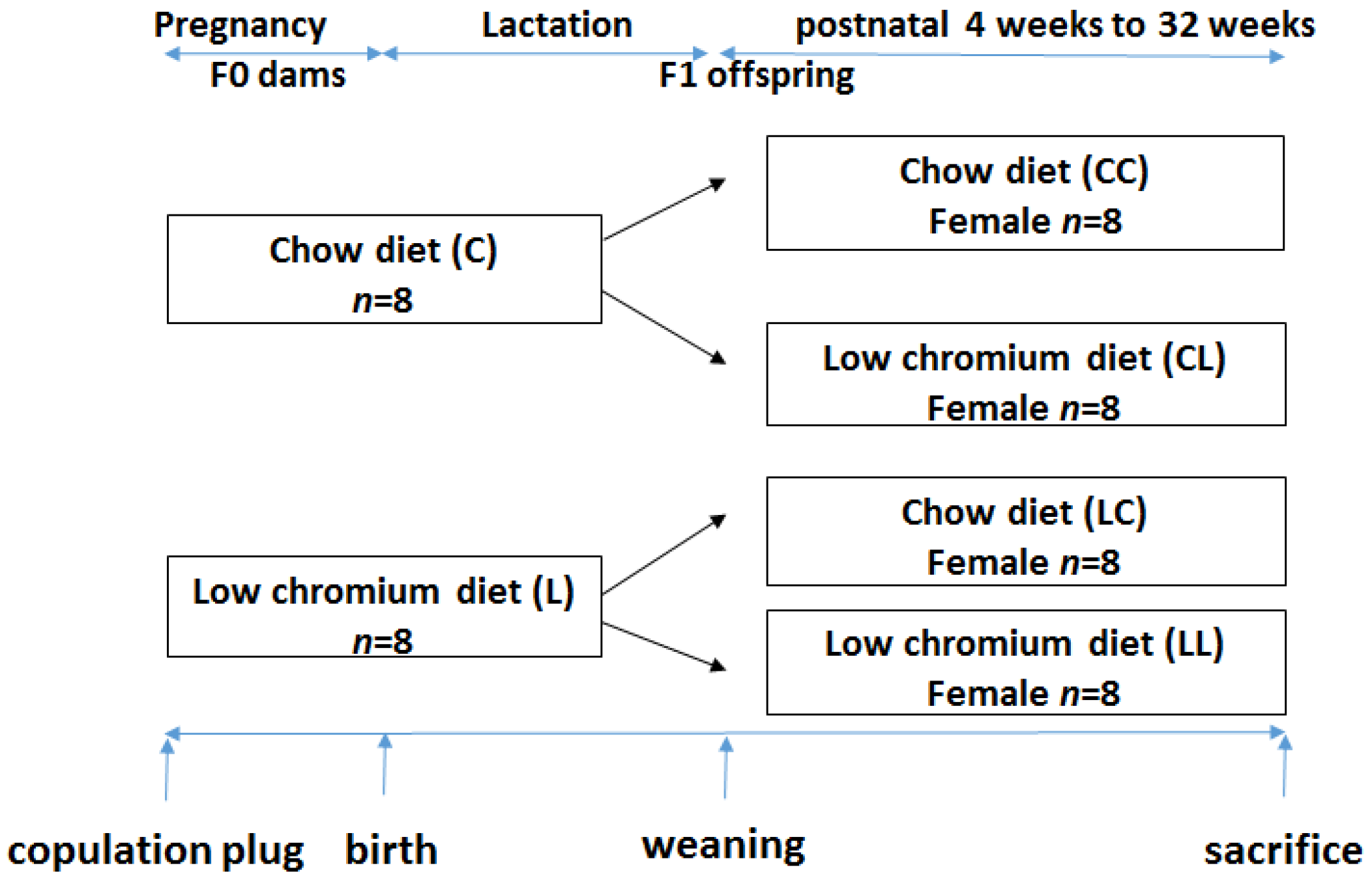
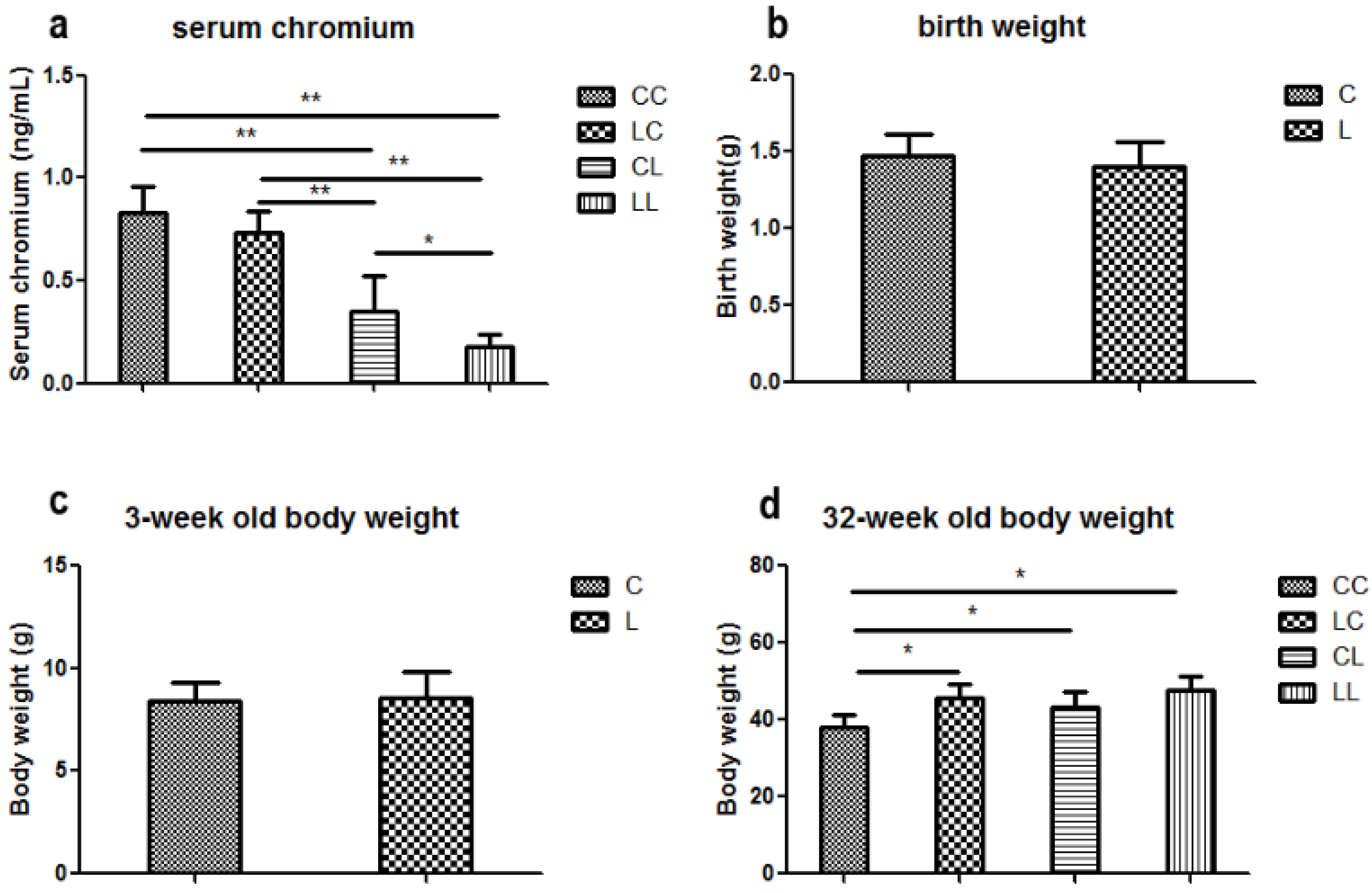
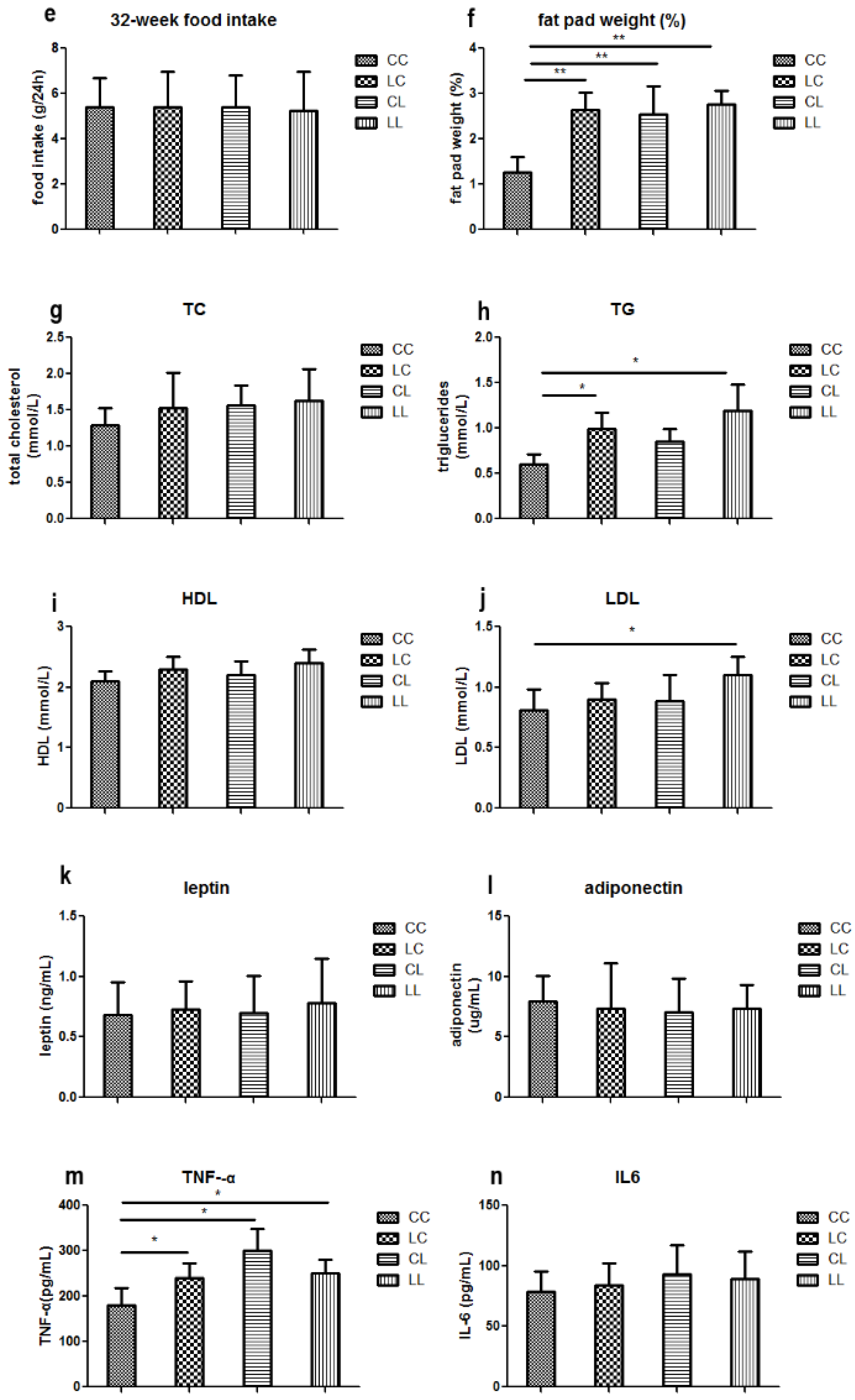
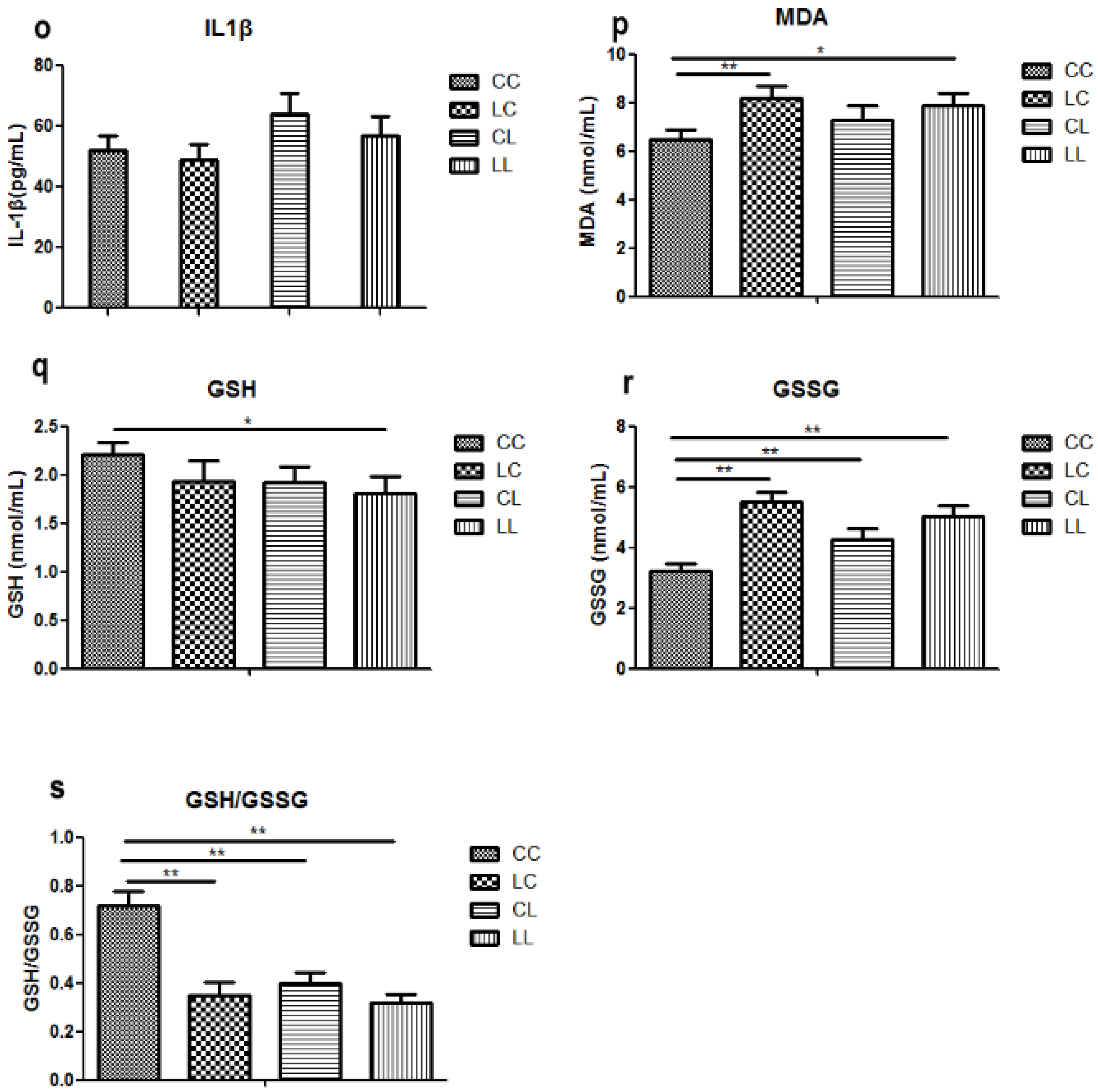
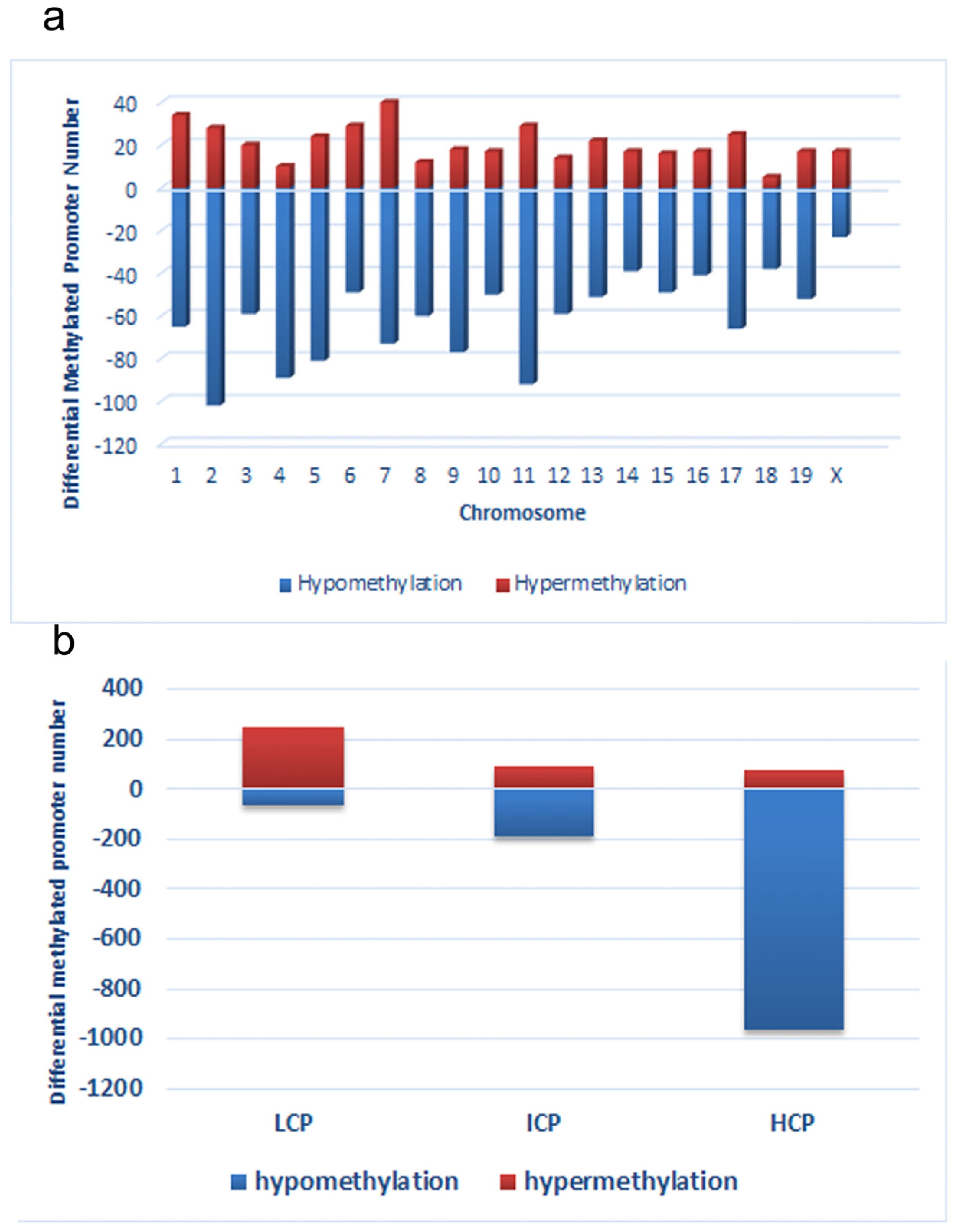
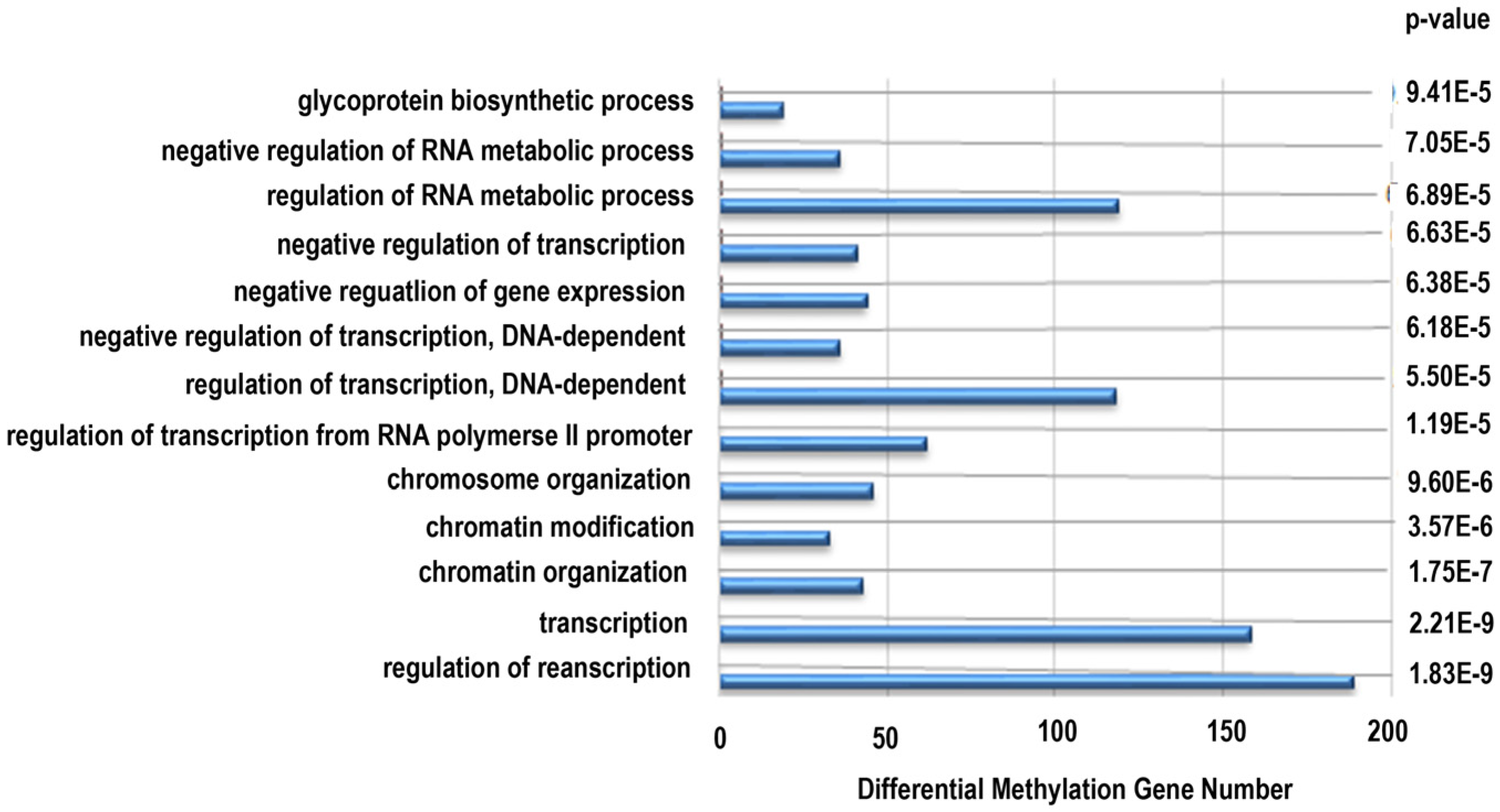
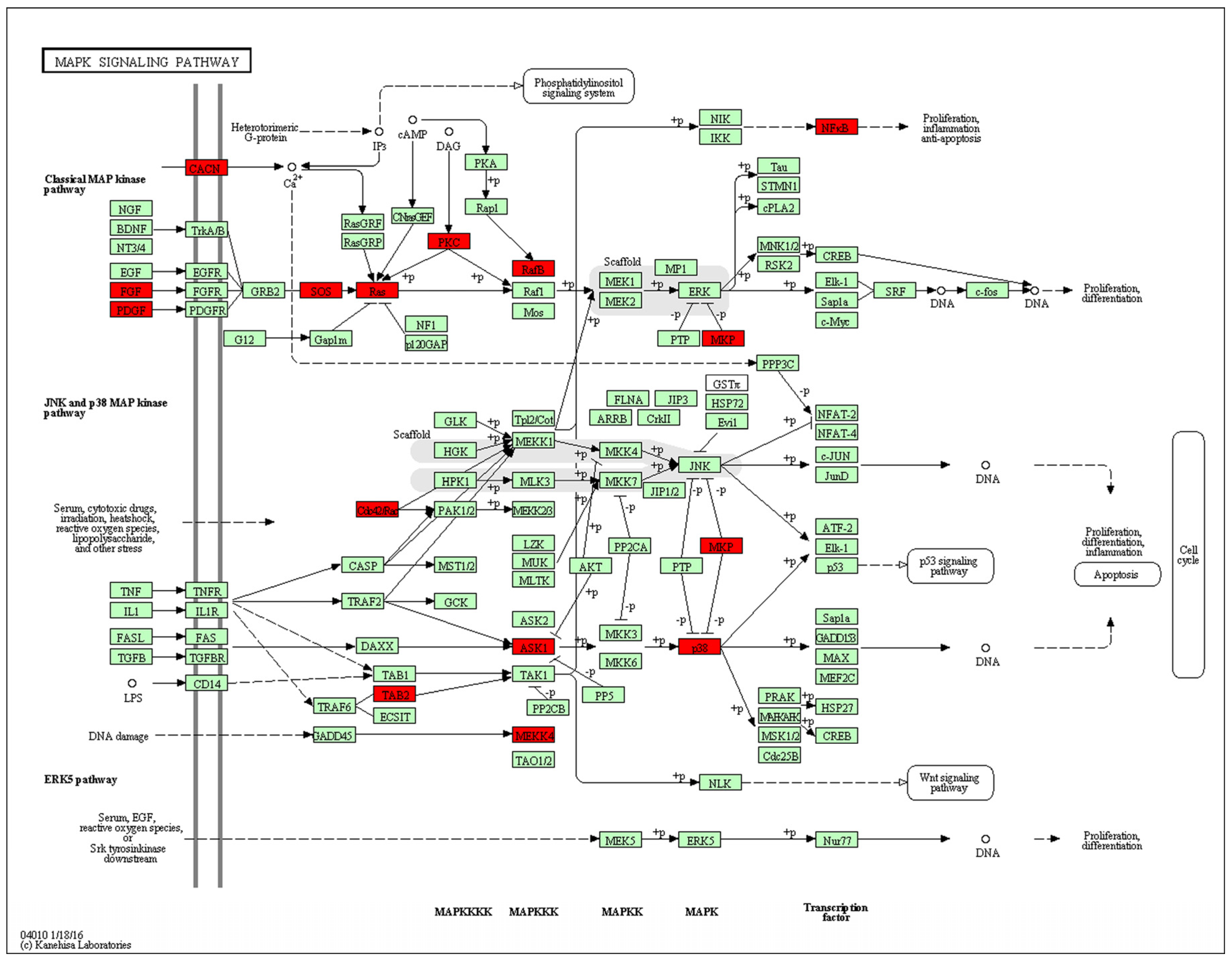

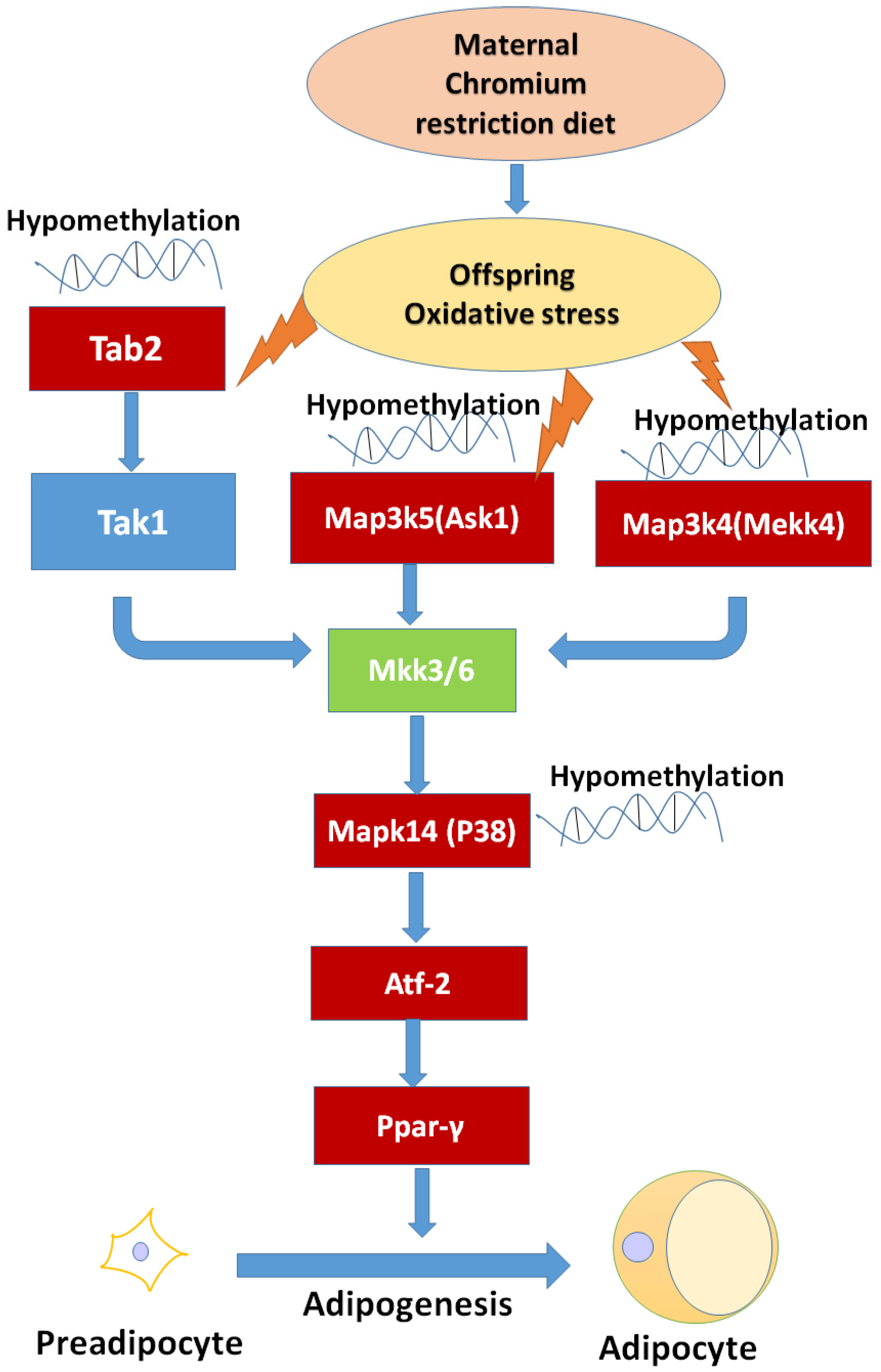
| Gene | Accession Number | Primer Sequences (from 5′ to 3′) | Production Size | CpG Number |
|---|---|---|---|---|
| Map3k4 | NM_011948 | F: 5′-AATGATTGAAAGATGTTTTGTT-3′ | 303 | 5 |
| R: 5′-TTCATAAACTAAAACTCAAAATCTC-3′ | ||||
| Mapk14 | NM_001168513 | F: 5′-GGAGTAAGTAGGGTGGTTTTGT-3′ | 382 | 30 |
| R: 5′-CAAACTTTACCCTACAACTCCTC-3′ | ||||
| Map3k5 | NM_008580 | F: 5′-GTAAGGGAGTTGTTGYGGAGTA-3′ | 258 | 35 |
| R: 5′-AAAAAAACAAAACTTCCTCCTCTT-3′ | ||||
| Tab2 | NM_138667 | F: 5′-TGTTGATTAAGGAAAGTTTAGYG-3′ | 252 | 34 |
| R: 5′-CRAAACCCTACAAACCCTAAC-3′ |
| Gene | Accession Number | Primer Sequences (from 5′ to 3′) | Production Size |
|---|---|---|---|
| Map3k4 | NM_011948 | F: 5′-ATTGGAGAAGGACAGTAT-3′ | 107 |
| R: 5′-ATAGTCTTGTGGTCGTTA-3′ | |||
| Mapk14 | NM_001168513 | F: 5′-TGTTCTGTCTATCTCACTTC-3′ | 75 |
| R: 5′-GAGGCACTTGAATGGTAT-3′ | |||
| Map3k5 | NM_008580 | F: 5′-AATAATGAAGTTGAGGAGAAGACA-3′ | 78 |
| R: 5′-AGAGGAAGCACCGAAGTT-3′ | |||
| Tab2 | NM_138667 | F: 5′-TATCAGTGCTTGGAATGG-3′ | 143 |
| R: 5′-GACCTTCTTAACGCTCAT-3′ | |||
| Pparg | NM_001127330 | F: 5′-GCATCAGGCTTCCACTAT-3′ | 75 |
| R: 5′-CTTCAATCGGATGGTTCTTC-3′ | |||
| Atf2 | NM_001025093 | F: 5′-GGCGTTCAAGCAGGATTC-3′ | 106 |
| R: 5′-TGACACTGAGACCATAGCAATA-3′ |
| Groups | C | L |
|---|---|---|
| Body weight (g) | 23.1 ± 3.5 | 22.3 ± 3.4 |
| Serum chromium (ng/mL) | 0.89 ± 0.22 | 0.45 ± 0.09 ** |
| Term | Term Number | Count | p-Value | Fold Enrichment |
|---|---|---|---|---|
| Biological process | - | - | - | - |
| regulation of transcription | GO:0045449 | 189 | 1.5015 | |
| transcription | GO:0006350 | 158 | 1.5775 | |
| chromatin organization | GO:0006325 | 43 | 2.4151 | |
| chromatin modification | GO:0016568 | 33 | 2.4737 | |
| chromosome organization | GO:0051276 | 46 | 2.0145 | |
| regulation of transcription from RNA polymerase II promoter | GO:0006357 | 62 | 1.7807 | |
| regulation of transcription, DNA-dependent | GO:0006355 | 118 | 1.4250 | |
| negative regulation of transcription, DNA-dependent | GO:0045892 | 36 | 2.0679 | |
| negative regulation of gene expression | GO:0010629 | 44 | 1.8987 | |
| negative regulation of transcription | GO:0016481 | 41 | 1.9500 | |
| regulation of RNA metabolic process | GO:0051252 | 119 | 1.4149 | |
| negative regulation of RNA metabolic process | GO:0051253 | 36 | 2.0546 | |
| glycoprotein biosynthetic process | GO:0009101 | 19 | 2.8731 | |
| Cellular componts | - | - | - | - |
| nuclear lumen | GO:0031981 | 86 | 1.8592 | |
| intracellular organelle lumen | GO:0070013 | 101 | 1.7017 | |
| organelle lumen | GO:0043233 | 101 | 1.6972 | |
| endomembrane system | GO:0012505 | 58 | 2.0695 | |
| membrane-enclosed lumen | GO:0031974 | 102 | 1.6585 | |
| Golgi apparatus | GO:0005794 | 68 | 1.9034 | |
| nucleoplasm | GO:0005654 | 57 | 1.8165 | |
| Golgi apparatus part | GO:0044431 | 29 | 2.4388 | |
| Golgi membrane | GO:0000139 | 20 | 2.7868 | |
| Molecular Function | - | - | - | - |
| DNA binding | GO:0003677 | 167 | 1.6952 | |
| transcription regulator activity | GO:0030528 | 113 | 1.6939 | |
| transcription factor activity | GO:0003700 | 76 | 1.7706 | |
| metal ion binding | GO:0046872 | 260 | 1.2209 | |
| cation binding | GO:0043169 | 262 | 1.2192 |
| Pathway Name | Pathway Term | Gene Count | Fold Enrichment | p-Value |
|---|---|---|---|---|
| Gap junction | mmu04540 | 11 | 2.6025 | 0.008845 |
| MAPK signaling pathway | mmu04010 | 23 | 1.7660 | 0.009097 |
| Gene Name | Accession | Chromosome | Peak to TSS | Promoter Classification | Peak Score | Peak M Value |
|---|---|---|---|---|---|---|
| Rac1 | NM_009007 | chr5 | 264 | HCP | 2.42 | 0.550 |
| Rela | NM_009045 | chr19 | 349 | HCP | 2.65 | 0.477 |
| Prkcb | NM_008855 | chr7 | 350 | HCP | 2.96 | 0.370 |
| Cacna1h | NM_001163691 | chr17 | 37 | HCP | 3.1 | 0.338 |
| Map3k4 | NM_011948 | chr17 | −422 | HCP | 3.48 | 0.334 |
| Tab2 | NM_138667 | chr10 | −175 | HCP | 3.68 | 0.312 |
| Fgf3 | NM_008007 | chr7 | 336 | HCP | 2.08 | 0.305 |
| Braf | NM_139294 | chr6 | 105 | HCP | 2.48 | 0.265 |
| Mapk14 | NM_001168513 | chr17 | −833 | HCP | 3.38 | 0.259 |
| Mapk14 | NM_001168514 | chr17 | 393 | HCP | 3.38 | 0.259 |
| Fgf18 | NM_008005 | chr11 | 85 | HCP | 2.93 | 0.258 |
| Map3k5 | NM_008580 | chr10 | −291 | HCP | 2.6 | 0.254 |
| Cacna2d3 | NM_009785 | chr14 | −314 | HCP | 2.94 | 0.251 |
| Pdgfa | NM_008808 | chr5 | −301 | HCP | 3.42 | 0.247 |
| Fgf8 | NM_010205 | chr19 | −231 | HCP | 2.59 | 0.218 |
| Cacnb4 | NM_001037099 | chr2 | 145 | ICP | 2.27 | 0.169 |
| Fgf11 | NM_010198 | chr11 | 117 | ICP | 2.11 | 0.144 |
| Hras1 | NM_001130444 | chr7 | −254 | HCP | 2.36 | 0.121 |
| Sos1 | NM_009231 | chr17 | −350 | HCP | 2.49 | 0.109 |
| Cacna1g | NM_001177890 | chr11 | −401 | HCP | 2.15 | 0.060 |
| 1500003O03Rik | NM_019769 | chr2 | 437 | HCP | 2.37 | 0.053 |
| Dusp16 | NM_130447 | chr6 | −410 | HCP | 2.18 | 0.038 |
| Prkx | NM_016979 | chrX | −253 | HCP | 2.22 | 0.035 |
| Nfkb2 | NM_001177370 | chr19 | −536 | ICP | 2.1 | 0.012 |
© 2016 by the authors; licensee MDPI, Basel, Switzerland. This article is an open access article distributed under the terms and conditions of the Creative Commons Attribution (CC-BY) license (http://creativecommons.org/licenses/by/4.0/).
Share and Cite
Zhang, Q.; Sun, X.; Xiao, X.; Zheng, J.; Li, M.; Yu, M.; Ping, F.; Wang, Z.; Qi, C.; Wang, T.; et al. Effects of Maternal Chromium Restriction on the Long-Term Programming in MAPK Signaling Pathway of Lipid Metabolism in Mice. Nutrients 2016, 8, 488. https://doi.org/10.3390/nu8080488
Zhang Q, Sun X, Xiao X, Zheng J, Li M, Yu M, Ping F, Wang Z, Qi C, Wang T, et al. Effects of Maternal Chromium Restriction on the Long-Term Programming in MAPK Signaling Pathway of Lipid Metabolism in Mice. Nutrients. 2016; 8(8):488. https://doi.org/10.3390/nu8080488
Chicago/Turabian StyleZhang, Qian, Xiaofang Sun, Xinhua Xiao, Jia Zheng, Ming Li, Miao Yu, Fan Ping, Zhixin Wang, Cuijuan Qi, Tong Wang, and et al. 2016. "Effects of Maternal Chromium Restriction on the Long-Term Programming in MAPK Signaling Pathway of Lipid Metabolism in Mice" Nutrients 8, no. 8: 488. https://doi.org/10.3390/nu8080488
APA StyleZhang, Q., Sun, X., Xiao, X., Zheng, J., Li, M., Yu, M., Ping, F., Wang, Z., Qi, C., Wang, T., & Wang, X. (2016). Effects of Maternal Chromium Restriction on the Long-Term Programming in MAPK Signaling Pathway of Lipid Metabolism in Mice. Nutrients, 8(8), 488. https://doi.org/10.3390/nu8080488





